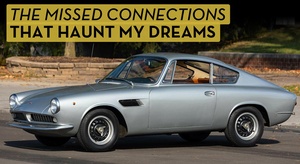I pulled the MSD billet HEI distributor out of my truck this weekend. I bought it new at least 10 years ago and it's probably seen almost 6-figure mileage in the interim. It's time for a cap & rotor, so I figured on a good cleaning and checkup. Upon inspection, the advance mechanism is flat worn out. Not unusual wear, just a lot of normal wear as can only be earned over 10s of millions of revolutions. Given the superior quality of build and materials, I'm a bit surprised, but really it's just a modestly improved version of what GM came up with when they rolled out the Delco points dizzy...what, 70 years ago? Difference is that the center cam on the MSD is TIG welded to the shaft, thus not replaceable. (Yeah, I know welding is also "only temporary") I'm not even going to try to send it to MSD for repair/rework. A new copy of same distributor is currently $530 and I don't need the module or coil. So, the rampaging Project Squirrel in my mind immediately got to thinking about Options.
First, let's list some reasons a classic GM HEI distributor is a good pick:
-Easy to find parts for and nearly ubiquitous.
-Easy to work on. Every self-respecting old-school wrench knows their way around one.
-Simple like rock. They just work, in that sweet spot of mediocrity, until the module fails. I do carry a spare MSD module since I need the dedicated square-wave tach signal for my Microsquirt TCU though.
-Cheap, in stock form. Someone will probably give you one from their parts stash if you ask nicely. I probably paid $2xx for my MSD version originally but the dollar is getting more expensive by the second.
-Decent performance, especially the fancied-up versions with hotter module and coil.
And some reasons they're not so great:
-Limited flexibility. You either run an HEI or something else, it's hard to hybridize or cross-pollinate (external coil, for example).
-Limited coil energy. This one isn't the HEI's fault, just a function of forcing any single coil to fire all an engine's plugs within a finite time window. After noticing firsthand the massive improvements in power and driveability converting a different vehicle from a single coil to waste-spark, I am fully aware the detriment of dwell-limited spark energy.
-Air makes a terrible conduit for that hard-earned spark energy. A spinning rotor sending spark across an air gap to the cap terminals is a fundamentally compromised design. Any mechanical distributor shares this handicap. Bonus demerits for the wear caused by arcing on said contacts over time, as well as the ionized dust that it generates and deposits in the airspace.
-Imprecision is inherent in any mechanical distributor, ultimately manifested as timing variation. There’s a lot of pieces, tolerances and clearances in play.
-Adjustability of advance curve is limited to what can be accomplished by geometry and Hooke’s law.
-Vacuum advance canister. Not that I have a better idea, but rotating the pickup coil is literally a "move the goalpost" approach. Ugh.
-Central, fixed location means long and unequal length plug wires.
-Sensitive to environmental conditions. Raise your hand if you've ever power-washed one by mistake or hit a large puddle and had to dry it out to get home.
So what are my options? There's a damn good reason GM and everyone else has gone to COP/CNP and I'd like to bring those benefits to my old BBC.
1. Waste-spark setup. This would use two coils with 4x outputs each. Not ideal on a V8 since each one needs to pair cylinders by firing order (1 with 6, 8 with 5, etc) so you'd have to run plug wires to both sides of the motor from each coil. The up-side is that whatever you use to fire the coils only needs a basic 90° increment trigger with a 1x crank reference and doesn't care where the motor is in its cycle, so no cam position sensor needed. I keep thinking about using the existing HEI (or another distributor) just for a trigger. I don't have a particular candidate ignition driver picked out but there's got to be something suitable for not a lot of money. Uncertainty remains how to interface with it and how tunable the timing is. And what about a MAP sensor for vacuum advance? And man, that rat's nest of plug wires... As details are addressed, this whole approach starts to sound more like an overly complicated DIY project with no upside over...
2. Individual coils. Prior to the advent of off-the-shelf dual-sync distributors, the only way to do fancy multi-coil ignition or sequential fuel injection on a dinosaur-level engine was an add-on crank-trigger and a 1x cam signal squeezed out of something creative. This can still be done but compensating for that extra ¼” trigger wheel thickness on a 3x V-belt drive is a royal pain. ATI makes trigger shells for their dampers that could work (I’m running a 7” ATI now) but they’re about the same price as the whole plain version. As the aftermarket support for EFI conversions has exploded in the last 20 years, so has the availability of dual-sync distributors. Currently, MSD makes complete conversion kits for V8s from the Big 3. Their Chevy kit comes with said dual-sync dizzy, eight LS2-style coils, plug wires, an ignition controller/driver, harness, and the other misc bits to make it work. It currently retails for $1425. Add your own coil brackets and case closed, albeit in trade for a rather large bag of gold. The controller does have a built-in MAP sensor for vacuum/boost timing adjustments and even a temp sensor to make temperature-driven adjustments. It's tuned by PC over USB, with user-selectable table values. What’s the downside to this approach? Mostly cost, with the DIY itch not being scratched a distant second.
So after that lengthy preamble, what other options does the hive suggest to implement an individual coil setup on a classic BBC?


































